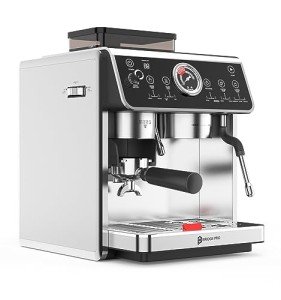The Rise of Home Espresso Machines: A Comprehensive Guide
As coffee fans continue to look for fresh and delicious brews in the house, the appeal of home espresso machines has actually surged recently. No longer just the domain of coffee shops and coffeehouse, these machines empower individuals to craft barista-quality espresso drinks from the convenience of their kitchens. This short article will check out the various kinds of home espresso machines, their functions, and factors to consider for selecting the best one. In addition, it will provide a choice of FAQs to help potential buyers make informed choices.
Kinds Of Home Espresso Machines
Home espresso machines can be classified into numerous categories based upon their systems and user-friendliness. Each type has its unique functions, pros, and cons.
| Type | Description | Pros | Cons |
|---|---|---|---|
| Manual Espresso Machines | Needs the user to by hand control the developing procedure, including methods like pulling a lever to create pressure. | - Complete control over brewing process - Compact design | - Requires ability and practice - Time-consuming |
| Semi-Automatic Machines | Machine automates water flow and pressure, but the user still controls the dosing and duration of the developing procedure. | - Balance of automation and control - Versatile | - Learning curve for perfecting strategies |
| Totally Automatic Machines | Automates the whole developing procedure, from grinding to brewing, often with programmable settings for personalized drinks. | - Extremely easy to use - Quick and hassle-free | - Less control over the developing procedure - Higher cost point |
| Pill or Pod Machines | Utilizes pre-packaged espresso pills or pods to develop coffee quickly and easily. | - Extremely simple to use - Minimal cleanup | - Limited taste variety - More expensive per cup than ground coffee |
| Super-Automatic Machines | Integrates features of completely automatic machines with built-in mills, permitting users to brew entire bean espresso and milk-based drinks with one touch. | - All-in-one convenience - Ideal for milk-based beverages | - Often the most costly - Can be bulky |
Functions to Consider
When selecting a home espresso machine, prospective buyers need to think about the following features to ensure they choose a machine that fulfills their needs:
Grinder Type:
- Built-in grinders can provide fresher grounds but may need more maintenance.
- Separate grinders permit more modification of grind size.
Pressure:
- Look for machines that produce a minimum of 9 bars of pressure, which is optimal for brewing espresso.
Water Temperature Control:
- Machines with adjustable temperature settings permit for much better extraction of flavor from beans.
Milk Frothing Options:
- Consider whether you desire a manual steam wand for frothing or an automatic milk frother for convenience.
Reduce of Cleaning:
- Machines with detachable parts and self-cleaning functions significantly minimize cleanup time.
Size and Design:
- Ensure the machine fits conveniently in your kitchen and aligns with your visual preferences.
Budget:
- Set a budget before starting your search, as costs can range substantially from affordable designs to high-end machines.
Benefits of Home Espresso Machines
Owning a home espresso machine provides many advantages:
- Cost-Effective: Over time, developing espresso at home can conserve coffee enthusiasts money compared to regular coffee shop check outs.
- Personalization: Users can explore different beans, grind sizes, and brewing methods to find their ideal cup.
- Convenience: The capability to brew espresso at any time removes the need to go out to a café, particularly advantageous during late nights or early mornings.
- Quality Control: With a home machine, people have complete control over the quality of components and developing processes.
Downsides of Home Espresso Machines
However, there are some disadvantages to consider:
- Initial Investment: High-quality espresso machines can be costly, needing a considerable upfront financial investment.
- Knowing Curve: Mastering the art of espresso developing can require time and practice, which may be frightening for newbies.
- Maintenance: Like any home appliance, espresso machines need regular cleaning and upkeep to ensure optimal performance.
FAQs
1. What is the very best kind of home espresso machine for beginners?
Answer: For newbies, a semi-automatic machine is often advised as it uses a balance in between control and automation, allowing you to learn the basics without frustrating intricacy.
2. Just how much should I invest in a home espresso machine?
Response: Entry-level machines can begin around ₤ 100 to ₤ 300, while higher-end designs can vary from ₤ 500 to over ₤ 2000. It's vital to set a budget based on your expected use and wanted features.
3. Do I need a different grinder?
Answer: While some espresso machines feature built-in grinders, investing in a separate grinder enables for greater customization and guarantees much better quality premises.
4. How often should I clean my espresso machine?
Response: Cleaning frequency can differ by machine type, however it's generally advised to clean up the machine after each use and carry out deep cleansings weekly or monthly, depending upon use.
5. Can Espresso Machines With Milk Frother make milk-based drinks with any espresso machine?
Answer: Not all machines come with milk frothing capabilities. If you delight in beverages like lattes or coffees, search for a machine with a steam wand or automatic frother.
Home espresso machines are changing the way coffee fanatics enjoy their beloved brews. With Check This Out and advanced functions available in the market, there is something for everyone. Whether it's the happiness of creating unique recipes or merely appreciating the perfect shot of espresso, purchasing a home espresso machine can improve both the coffee-drinking experience and the lifestyle for coffee lovers everywhere. As with any investment, it is crucial to weigh the advantages against the possible downsides and pick a machine that perfectly fits both your lifestyle and preferences.

